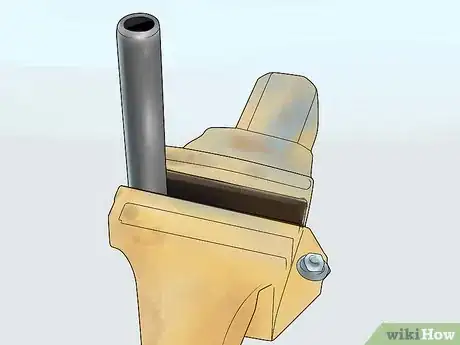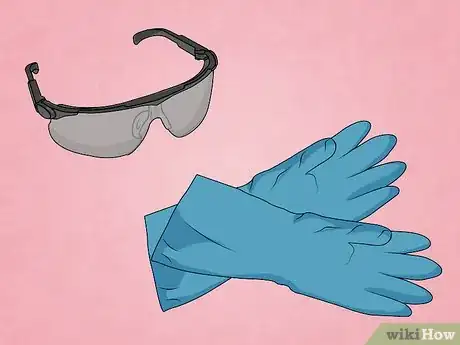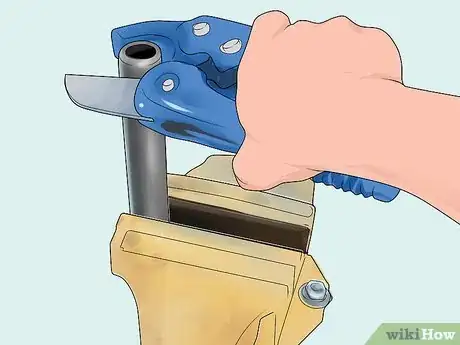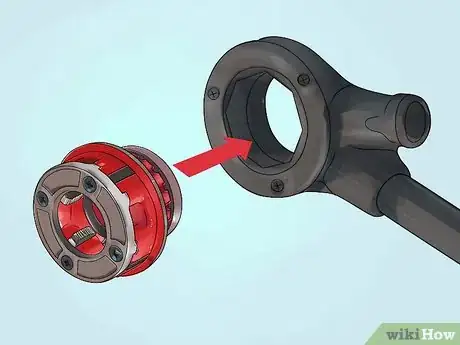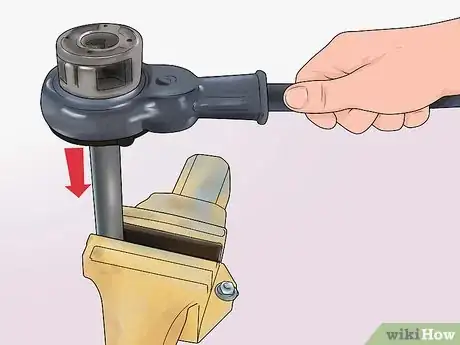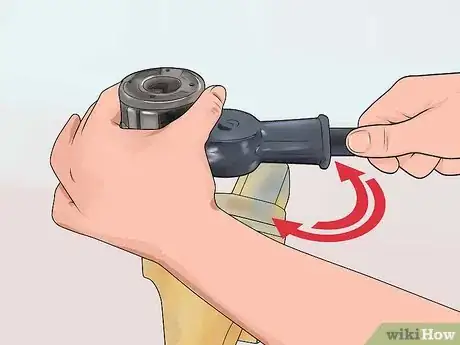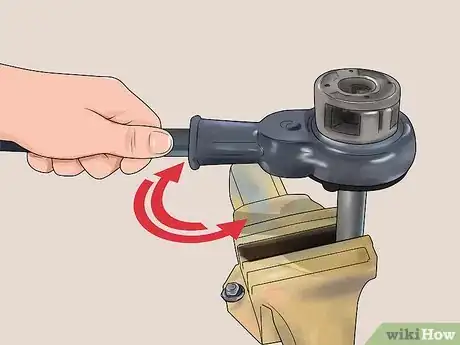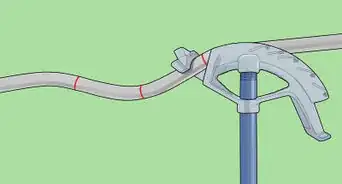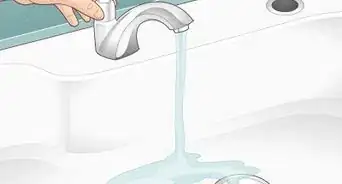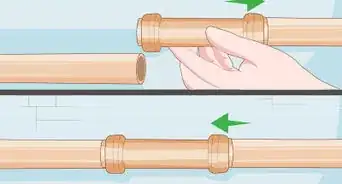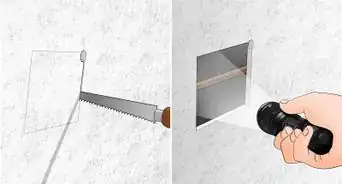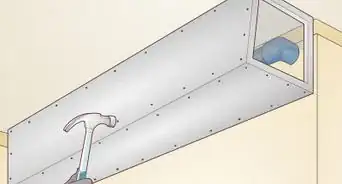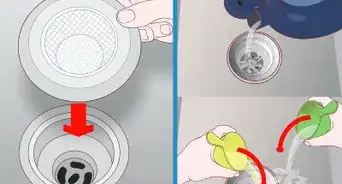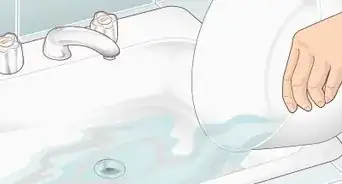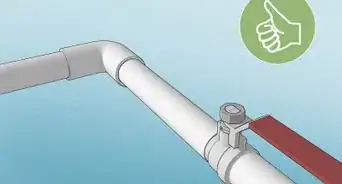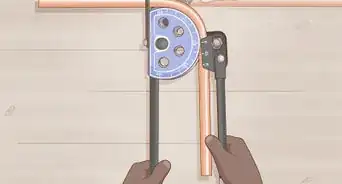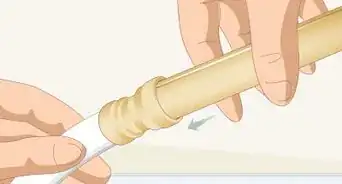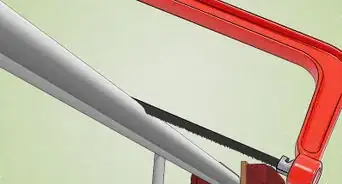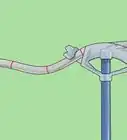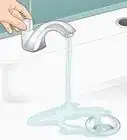This article was co-authored by wikiHow Staff. Our trained team of editors and researchers validate articles for accuracy and comprehensiveness. wikiHow's Content Management Team carefully monitors the work from our editorial staff to ensure that each article is backed by trusted research and meets our high quality standards.
There are 12 references cited in this article, which can be found at the bottom of the page.
This article has been viewed 247,507 times.
Learn more...
When you’re making plumbing repairs or installing new plumbing, it may be necessary to add threading to a damaged pipe or cut threads on the end of a new pipe. Purchase or rent a manual ratcheting pipe threader and use it to thread piping yourself. If you are planning to do a lot of pipe threading or have a plumbing business, there are also hand-held power threaders and threading machines that you could use. However, these types of automatic threaders are very expensive and not practical for simple home use when an affordable ratcheting pipe threader can get the job done just as well.
Steps
Getting the Threads Started
-
1Secure the pipe firmly in a vise. Loosen the jaws of the vise by turning the handle counterclockwise just far enough to fit the pipe between them. Place the pipe in the vise so the end you want to thread is sticking out, then turn the handle back clockwise to tighten it and secure it in place.[1]
- Note that you can use either a regular table vise or a pipe vise that is specially designed for holding piping in place.
- This method uses a ratcheting pipe threader to cut threads into the end of a pipe. A ratcheting pipe threader consists of a long ratcheting handle that holds a circular die head at one end, which is a ring with several sets of teeth inside of it that cut the threads. When you ratchet the handle, the die head spins onto the end of the pipe, cutting the threads as it goes on.
- If you don’t have all the equipment or don’t want to purchase or rent it, you can also have pipes threaded for you at a home improvement center.
-
2Put on work gloves and safety glasses. These will protect your hands and eyes from any metal slivers and accidental cuts. It will also keep your hands clean as you lubricate the pipe and pipe threader throughout the process.[2]
- You can just wear 1 work glove if you prefer to leave 1 hand bare to grip the handle of pipe threader better.
Advertisement -
3Cut and ream the pipe if you need to make it a different length. Use a pipe cutter or a hacksaw to cut the pipe to length. Insert a reamer in the cut end of the pipe and rotate it around to remove sharp burrs and smooth the end out.[3]
- A reamer is a cone-shaped manual rotary cutting tool that removes the rough edges of a cut pipe as you rotate it around inside of the cut end.
-
4Choose a die head based on the pipe’s diameter. Read the numbers on the different die heads for the ratcheting pipe threader to see what sizes they are. Select a die head that is of the appropriate size for the pipe you want to add threads to.[4]
- A die head is the part of the pipe threader that actually cuts the threads. Ratcheting pipe threaders typically come with die heads in a few different common diameters. The face of the die head has numbers on it that indicate the size of pipe it is for. For example, if it says 1/2 on it, the die head is for threading 1/2-inch piping.
- You can purchase or rent a ratcheting pipe threader and die heads at a home improvement center or hardware store. An inexpensive ratcheting pipe threader with 5-6 different die heads costs between $40-$60 USD.
-
5Attach the die head to a ratcheting pipe threader handle. Remove any die head that is already in the handle by pulling it out. Slide your selected die head into ring at the end of the handle until it snaps all the way into place.[5]
- The ratcheting handle is the handle you use to move it around the end of the pipe to cut the threads in it.
Tip: Most ratcheting pipe threaders can be used to thread pipes made out of different materials like galvanized metal, copper, or PVC.
-
6Lubricate the end of the pipe with threading oil. Apply a generous squeeze or two of threading oil to the outside end of the pipe. This will lubricate it so it’s easier to put the die head on as well as lubricate the teeth of the die head, making it easier to cut the threads.[6]
- Don’t worry about applying too much lubricant. You need a lot to get the job done, so just squirt away until you have completely saturated the outside end of the pipe that you are going to cut threads into.
-
7Place the die head onto the end of the pipe. Slide the center hole of the die cutter onto the end of the pipe. Push it into place as far as it will go.[7]
- If it’s hard to get onto the pipe, you can squirt some more threading oil onto the pipe and the middle of the die head to make it easier.
-
8Ratchet the handle while applying pressure to the die head to start cutting. Push against the die head, towards the pipe, with 1 hand. Ratchet the pipe threader’s handle clockwise with your other hand as far as you can go, maintaining pressure on the die head as you do so to make the teeth start cutting into the pipe.[8]
- If you feel resistance as you do this, then you know the teeth are biting into the pipe and starting to cut the threads. If you don’t feel any resistance, you probably need to push harder on the die head.
Cutting and Finishing the Threads
-
1Lubricate the exposed teeth of the die head. Squeeze more threading oil onto all the teeth of the die head that are not yet cutting into the pipe. This is important to make cutting easier and prevent wear and tear on the teeth.[9]
- Don’t be shy about squirting on the threading oil. You can’t use too much lubricant during this process.
-
2Keep ratcheting the handle until all the die head’s teeth have cut into the pipe. Turn the handle back counterclockwise about 3/4 of the way, then ratchet it clockwise as far as you can go, using your bodyweight to help you turn it. Repeat this until all the die head’s teeth are around the pipe, which means all the threads have been cut.[10]
- If at any point you feel increased resistance while cutting, stop ratcheting and apply more threading oil to the exposed teeth of the die head.
-
3Reverse the direction of the ratchet handle and ratchet it off the threads. Pull up the little black knob next to the die head and turn it to reverse the direction of the ratchet handle. Ratchet it counterclockwise as far as it will go, then turn it back clockwise about 3/4 of the way, and repeat until you have unscrewed the teeth of the die head from the threads.[11]
- When you have unscrewed the die head all the way, you can simply pull it to slide it off the end of the pipe.
-
4Wrap Teflon tape clockwise around the threads at the end of the pipe. Seal the threads with 2-3 wraps of teflon tape before you attach any connectors or fittings. This will ensure a tight, well-sealed connection.[12]
- You can also use a liquid pipe thread compound instead of Teflon tape to create a strong seal.
Tip: Check the manufacturer’s instructions on the Teflon tape’s packaging for specific recommendations on the number of wraps. Different diameters of piping may require different numbers of wraps to get a tight seal.
Community Q&A
-
QuestionIs the die for standard pipe the same as for thick wall pipe?
 Community AnswerYes, the die is the same.
Community AnswerYes, the die is the same. -
QuestionHow do I check the threads after cutting?
 Community AnswerI usually do a visual examination and then test out the threads. Clean all of the oil and metal shavings off the thread you made and look closely at them for burrs or chips. These won't be a deal breaker. You can shave off a burr if it is too big and chips won't be a problem unless they catch on whatever you are screwing onto the pipe. After I look at the threads, I usually take a fitting (preferably the one that will be screwed onto those threads) and put it on hand tight. If it catches anywhere, give the fitting a small turn with a wrench to see if you can break past whatever is stopping you. I like to check with a second fitting if the first doesn't go just to be sure.
Community AnswerI usually do a visual examination and then test out the threads. Clean all of the oil and metal shavings off the thread you made and look closely at them for burrs or chips. These won't be a deal breaker. You can shave off a burr if it is too big and chips won't be a problem unless they catch on whatever you are screwing onto the pipe. After I look at the threads, I usually take a fitting (preferably the one that will be screwed onto those threads) and put it on hand tight. If it catches anywhere, give the fitting a small turn with a wrench to see if you can break past whatever is stopping you. I like to check with a second fitting if the first doesn't go just to be sure. -
QuestionDo the brass fittings need to be tightened using a spanner?
 Community AnswerSometimes. I like to tighten them a bit extra if the contents of the pipe are pressurized. If the fitting isn't a permanent fixture and will be removed and reused in the future, I only hand tighten it since brass is soft and it will warp over time.
Community AnswerSometimes. I like to tighten them a bit extra if the contents of the pipe are pressurized. If the fitting isn't a permanent fixture and will be removed and reused in the future, I only hand tighten it since brass is soft and it will warp over time.
Warnings
- Wear work gloves and safety glasses to protect yourself while threading a pipe.⧼thumbs_response⧽
- If your pipe was metal, be cautious about getting the shavings on your skin as they will be sharp.⧼thumbs_response⧽
Things You’ll Need
- Ratcheting pipe threader
- Die heads
- Safety glasses
- Work gloves
- Threading oil
- Pipe cutter
- Reamer
- Rag
- Teflon tape
References
- ↑ https://www.youtube.com/watch?v=32pzriZO1xc&feature=youtu.be&t=253
- ↑ https://www.youtube.com/watch?v=32pzriZO1xc&feature=youtu.be&t=256
- ↑ https://www.youtube.com/watch?v=egU3Aa-LW8Q&feature=youtu.be&t=40
- ↑ https://www.plumbermag.com/how-to-articles/pipe-threading-ridgid/select-a-pipe-threader-that-is-right-for-your-business
- ↑ https://www.youtube.com/watch?v=32pzriZO1xc&feature=youtu.be&t=166
- ↑ https://www.youtube.com/watch?v=32pzriZO1xc&feature=youtu.be&t=280
- ↑ https://www.youtube.com/watch?v=32pzriZO1xc&feature=youtu.be&t=295
- ↑ https://www.youtube.com/watch?v=32pzriZO1xc&feature=youtu.be&t=320
- ↑ https://www.youtube.com/watch?v=egU3Aa-LW8Q&feature=youtu.be&t=80
About This Article
Threading a pipe refers to adding threads to the end of a pipe so it can be screwed into place. You can thread a pipe by attaching and rotating a die head to cut the threads into the pipe. Start by securing the pipe firmly in a vise so it doesn’t move. Then, choose a die head based on the pipe’s diameter and attach it to a ratcheting pipe threader handle. Apply some lubricating oil to the end of the pipe and fit the die head onto it. To start cutting the threads, ratchet the handle while applying downward pressure to the die head. Keep ratcheting the handle until all of the die head’s teeth have cut into the pipe. Finally, reverse the direction of the ratchet handle and continue turning it until it comes off of the pipe. For tips about how to cut the pipe if you need to make it a different length, keep reading!
